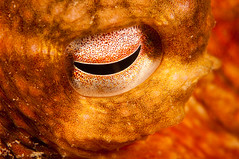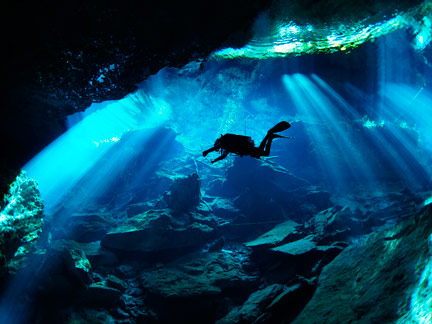 Note: this is an older story, but a good one, from an encounter a few of years ago...
Note: this is an older story, but a good one, from an encounter a few of years ago...My good friend Doc Kay has been busy retaking his diving medicine boards, family, and like, and readily agreed to my suggestion we take the good boat Komokwa (a beautiful Carver 37’) out for some scuba diving recently.
Seven of us showed up at 8:30 am; Ed Kay, Randy Williams and Randi Weinstein, Steve Lacey, Paul Riggs, my girlfriend and myself. After loading the usual ton of gear, we got underway and through the locks quickly.
Reaching Blakely Rocks, the tide was starting to slack, so we got ready to dive taking a while for each buddy pair to get dressed and into the water. Going down the buoy line we ran into stronger than expected currents and poor visability, maybe 15' or so. I gave my girlfriend the 10-cent tour, taking her to the wolf eel den, where they surprised us with a large egg mass that they were tending. We enjoyed some of the small anemones, sponge and nudibranchs as we went back over the top of the ridge to go back down the slope to the deeper part of the dive. We reached 70' or so and started to swim through the boulder garden down there and look for other critters. Swimming along, I saw one of the boulders had eyes.
Huh? Yup, we did a double take. Here was one of the largest Giant Pacific Octopus I had ever seen, out in the open, sitting on a rock, blending into it with a brown and white mottling. It was just humongous, with a head about 2.5 basketballs large. It was about the size of my girlfriend and when it stretched out its arms to examine us, it was probably 12-15' arm to arm and least 80-100#. And it was in no way scared. Quite the opposite, it was looking at us to be food or a sexual partner.
 We
shook hands with it and we started to examine each other. Even with us
both hitting the Octo with our powerful HID lights, it was just curious.
It was pretty aggressive and we kept backing off and then petting it
when it turned its attention on the other diver. It tried to put an arm
over my friend's mask and she wasn't too happy with that idea, nor was I
when it grabbed my gauge console. My friend got on the other side of me, as I
cavalierly patted it on the head and scratched it between the eyes.
Well, my cats like it…
We
shook hands with it and we started to examine each other. Even with us
both hitting the Octo with our powerful HID lights, it was just curious.
It was pretty aggressive and we kept backing off and then petting it
when it turned its attention on the other diver. It tried to put an arm
over my friend's mask and she wasn't too happy with that idea, nor was I
when it grabbed my gauge console. My friend got on the other side of me, as I
cavalierly patted it on the head and scratched it between the eyes.
Well, my cats like it…Note: DO NOT DO THIS TO 100#, 15' MOLLUSKS WITH 8 ARMS.
It had had enough of me playing with it, and suddenly flew up vertically so that all I was seeing was 15' feet of suckers and mouth flying at me. I'm not sure quite what I did, sort of a twisting, backwards half gainer. The Octo then swam off with a spurt and landed on a rock and glared at us in the gloom. We also had had enough, and swam the heck back up the slope. After circling around a bit (and seeing another Octo way back in the middle of a rock (where they should be), we spotted Randy and the others and found the buoy line, about an hour's dive to 70' max. This was certainly one of the most aggressive encounters I have had with these magnificent creatures. They usually are timid, or curious, but not aggressive.
Another great day on, and under, the water in Puget Sound.





